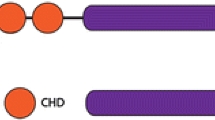Abstract
Chromatin remodelling proteins are an essential family of eukaryotic proteins. They harness the energy from ATP hydrolysis and apply it to alter chromatin structure in order to regulate all aspects of genome biology. Chromodomain helicase DNA-binding protein 1 (CHD1) is one such remodelling protein that has specialised nucleosome organising abilities and is conserved across eukaryotes. CHD1 possesses a pair of tandem chromodomains that directly precede the core catalytic Snf2 helicase-like domain, and a C-terminal SANT-SLIDE DNA-binding domain. We have identified an additional conserved domain in the C-terminal region of CHD1. Here, we report the backbone and side chain resonance assignments for this domain from human CHD1 at pH 6.5 and 25 °C (BMRB No. 25638).


Similar content being viewed by others
References
Allen MD, Religa TL, Freund SM, Bycroft M (2007) Solution structure of the BRK domains from CHD7. J Mol Biol 371:1135–1140. doi:10.1016/j.jmb.2007.06.007
Burkhardt L, Fuchs S, Krohn A, Masser S, Mader M, Kluth M, Bachmann F, Huland H, Steuber T, Graefen M, Schlomm T, Minner S, Sauter G, Sirma H, Simon R (2013) CHD1 is a 5q21 tumor suppressor required for ERG rearrangement in prostate cancer. Cancer Res 73:2795–2805. doi:10.1158/0008-5472.CAN-12-1342
Flaus A, Martin DM, Barton GJ, Owen-Hughes T (2006) Identification of multiple distinct Snf2 subfamilies with conserved structural motifs. Nucleic Acids Res 34:2887–2905. doi:10.1093/nar/gkl295
Gaspar-Maia A, Alajem A, Polesso F, Sridharan R, Mason MJ, Heidersbach A, Ramalho-Santos J, McManus MT, Plath K, Meshorer E, Ramalho-Santos M (2009) Chd1 regulates open chromatin and pluripotency of embryonic stem cells. Nature 460:863–868. doi:10.1038/nature08212
Gkikopoulos T, Schofield P, Singh V, Pinskaya M, Mellor J, Smolle M, Workman JL, Barton GJ, Owen-Hughes T (2011) A role for Snf2-related nucleosome-spacing enzymes in genome-wide nucleosome organization. Science 333:1758–1760. doi:10.1126/science.1206097
Keller R (2004) The computer aided resonance assignment tutorial, 1st edn. CANTINA Verlag, Switzerland
Mansfield RE, Musselman CA, Kwan AH, Oliver SS, Garske AL, Davrazou F, Denu JM, Kutateladze TG, Mackay JP (2011) Plant homeodomain (PHD) fingers of CHD4 are histone H3-binding modules with preference for unmodified H3K4 and methylated H3K9. J Biol Chem 286:11779–11791. doi:10.1074/jbc.M110.208207
Marley J, Lu M, Bracken C (2001) A method for efficient isotopic labeling of recombinant proteins. J Biomol NMR 20:71–75. doi:10.1023/A:1011254402785
Ryan DP, Owen-Hughes T (2011) Snf2-family proteins: chromatin remodellers for any occasion. Curr Opin Chem Biol 15:649–656. doi:10.1016/j.cbpa.2011.07.022
Ryan DP, Sundaramoorthy R, Martin D, Singh V, Owen-Hughes T (2011) The DNA-binding domain of the Chd1 chromatin-remodelling enzyme contains SANT and SLIDE domains. EMBO J 30:2596–2609. doi:10.1038/emboj.2011.166
Serrano P, Pedrini B, Mohanty B, Geralt M, Herrmann T, Wuthrich K (2012) The J-UNIO protocol for automated protein structure determination by NMR in solution. J Biomol NMR 53:341–354. doi:10.1007/s10858-012-9645-2
Skene PJ, Hernandez AE, Groudine M, Henikoff S (2014) The nucleosomal barrier to promoter escape by RNA polymerase II is overcome by the chromatin remodeler Chd1. Elife 3:02042. doi:10.7554/eLife.02042
Acknowledgments
This work was supported by a Grant (1063301) from the National Health and Medical Research Council of Australia (NHMRC). J.P.M. was supported by an NHMRC Senior Research Fellowship (1058916). D.P.R. was supported by a NHMRC CJ Martin (Biomedical) Fellowship (457137).
Author information
Authors and Affiliations
Corresponding authors
Rights and permissions
About this article
Cite this article
Mohanty, B., Silva, A.P.G., Mackay, J.P. et al. 1H, 13C and 15N resonance assignments of a C-terminal domain of human CHD1. Biomol NMR Assign 10, 31–34 (2016). https://doi.org/10.1007/s12104-015-9631-1
Received:
Accepted:
Published:
Issue Date:
DOI: https://doi.org/10.1007/s12104-015-9631-1




